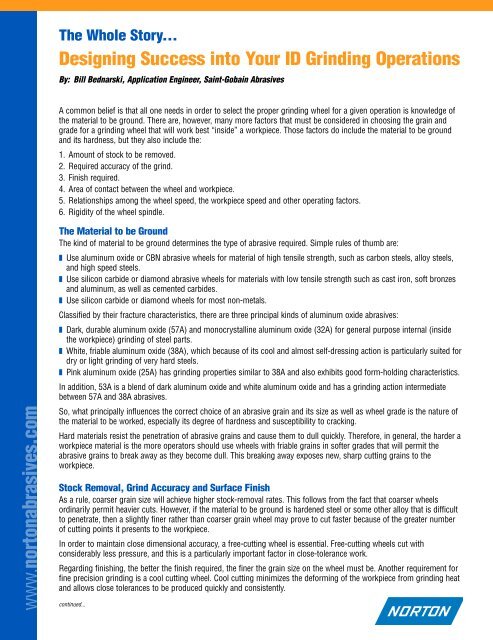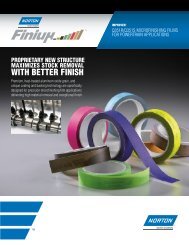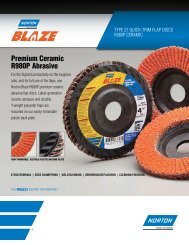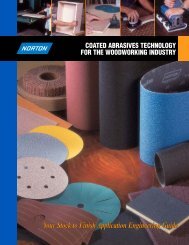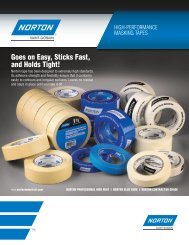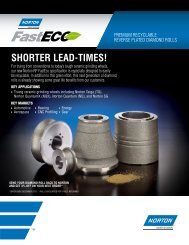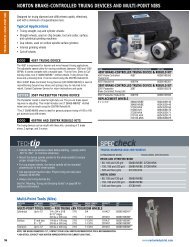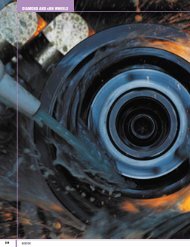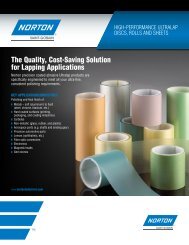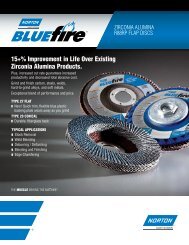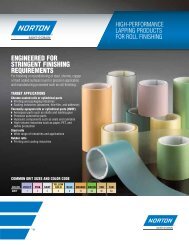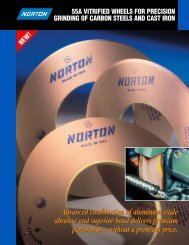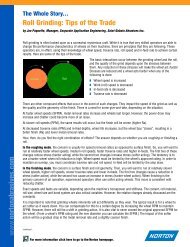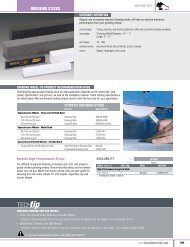Designing Success into Your ID Grinding Operations - Norton
Designing Success into Your ID Grinding Operations - Norton
Designing Success into Your ID Grinding Operations - Norton
Create successful ePaper yourself
Turn your PDF publications into a flip-book with our unique Google optimized e-Paper software.
The Whole Story...<strong>Designing</strong> <strong>Success</strong> <strong>into</strong> <strong>Your</strong> <strong>ID</strong> <strong>Grinding</strong> <strong>Operations</strong>By: Bill Bednarski, Application Engineer, Saint-Gobain AbrasivesA common belief is that all one needs in order to select the proper grinding wheel for a given operation is knowledge ofthe material to be ground. There are, however, many more factors that must be considered in choosing the grain andgrade for a grinding wheel that will work best “inside” a workpiece. Those factors do include the material to be groundand its hardness, but they also include the:1. Amount of stock to be removed.2. Required accuracy of the grind.3. Finish required.4. Area of contact between the wheel and workpiece.5. Relationships among the wheel speed, the workpiece speed and other operating factors.6. Rigidity of the wheel spindle.www.nortonabrasives.comThe Material to be GroundThe kind of material to be ground determines the type of abrasive required. Simple rules of thumb are:❚ Use aluminum oxide or CBN abrasive wheels for material of high tensile strength, such as carbon steels, alloy steels,and high speed steels.❚ Use silicon carbide or diamond abrasive wheels for materials with low tensile strength such as cast iron, soft bronzesand aluminum, as well as cemented carbides.❚ Use silicon carbide or diamond wheels for most non-metals.Classified by their fracture characteristics, there are three principal kinds of aluminum oxide abrasives:❚ Dark, durable aluminum oxide (57A) and monocrystalline aluminum oxide (32A) for general purpose internal (insidethe workpiece) grinding of steel parts.❚ White, friable aluminum oxide (38A), which because of its cool and almost self-dressing action is particularly suited fordry or light grinding of very hard steels.❚ Pink aluminum oxide (25A) has grinding properties similar to 38A and also exhibits good form-holding characteristics.In addition, 53A is a blend of dark aluminum oxide and white aluminum oxide and has a grinding action intermediatebetween 57A and 38A abrasives.So, what principally influences the correct choice of an abrasive grain and its size as well as wheel grade is the nature ofthe material to be worked, especially its degree of hardness and susceptibility to cracking.Hard materials resist the penetration of abrasive grains and cause them to dull quickly. Therefore, in general, the harder aworkpiece material is the more operators should use wheels with friable grains in softer grades that will permit theabrasive grains to break away as they become dull. This breaking away exposes new, sharp cutting grains to theworkpiece.Stock Removal, Grind Accuracy and Surface FinishAs a rule, coarser grain size will achieve higher stock-removal rates. This follows from the fact that coarser wheelsordinarily permit heavier cuts. However, if the material to be ground is hardened steel or some other alloy that is difficultto penetrate, then a slightly finer rather than coarser grain wheel may prove to cut faster because of the greater numberof cutting points it presents to the workpiece.In order to maintain close dimensional accuracy, a free-cutting wheel is essential. Free-cutting wheels cut withconsiderably less pressure, and this is a particularly important factor in close-tolerance work.Regarding finishing, the better the finish required, the finer the grain size on the wheel must be. Another requirement forfine precision grinding is a cool cutting wheel. Cool cutting minimizes the deforming of the workpiece from grinding heatand allows close tolerances to be produced quickly and consistently.continued...
...continuedArea of ContactFor internal or <strong>ID</strong> grinding as compared to cylindrical orsurface grinding, the contact area is much larger. It isespecially large in some small bore grinding where it isnecessary to use wheels just slightly smaller in diameterthan the hole itself. A large area of contact with theworkpiece makes it necessary to use wheels of relativelysoft grades with open structures to provide sufficient chipclearance. This kind of cutting also requires a normalfracture of dulled grains in order to keep the wheel sharpand free cutting. Interrupted surfaces such as a hole witha keyway calls for a harder wheel to offset the dressingaction of the sharp (keyway) edges on the wheel.Significant dulling is a factor due to high contact area/low forcesInternal grinding has alarge, wrap contact area.This creates low forces inthe contact area.Surface grinding hasa small contact areaExternal grinding has linebetween part andcontact between part andwheel. It is slightlywheel.more than externalgrinding.Wheel-size RecommendationsHere are recommended grinding wheel sizes for internal or <strong>ID</strong> grinding based on the hole size:Hole Diameter (inches) Wheel Diameter (% of hole size)0 to ½ < 90½ to 2 852 to 6 80> 6 70 to 50A wheel that is too large creates low pressure on the wheel and can dull the wheel. It also blocks coolant flow that canresult in poor chip removal from the grinding area. A wheel that is too small results in inefficient grinding because a smallamount of abrasive is presented to the workpiece. Wheels that are too small encourage excessive pressures on wheelsthat produce excessive wheel wear. Generally, a wheel should be replaced with a like wheel when it reaches 70% of itsoriginal size.www.nortonabrasives.comWorkpiece Speed, Wheel Speed and Operating FactorsThe higher the workpiece speed in relation to the wheel, the greater is the force that’s imposed on the wheel and the“softer” the wheel will “act”. By contrast, as the wheel speed increases the imposed force on the wheel is lower and thewheel “acts harder”. Typical operating wheel speeds should be around 8,500 sfpm (surface feet per minute) but canrange from 4,500 to 12,500 sfpm.Important factors about wheel speed include the following:❚ Maintain the proper sfpm and use a constant surface feet speed if you can.❚ sfpm = wheel rpm wheel diameter 0.2618.❚ Reducing wheel speed will cause the wheel to “act” softer.❚ Increasing wheel speed will cause the wheel to “act” harder.General rules of thumb for work speed include the following:❚ Work speed to wheel speed ratio should be in the range of 25:1 to 65:1.❚ Increasing work speed makes the wheel “act” softer❚ Decreasing work speed makes the wheel “act” harder❚ For materials with a Rockwell C hardness (Rc) of 50 or less, sfpm wheel = sfpm work ÷ 30.❚ For materials with an Rc of 51 or more, sfpm wheel = sfpm work ÷ 55.continued...
...continuedGeneral rules of thumb regarding operating factors include the following:❚ Infeed rates (starting points)==>For materials Rc 50 and softer -Rough rates: use 0.00015 in. - 0.00010 in. stock removed per part wheel revolution.Finish rates: use 0.00005 in. - 0.00003 in.==>For materials Rc 51 and harder -Rough rates: use 0.00010 in. - 0.00005 in. stock removed per part wheel revolution.Finish rates: use 0.00005 in. - 0.00003 in.❚ Oscillation rate==>Typically 75 in./min. to 125 in./min.==>Starting point: use 0.2 wheel width rpm work<strong>Grinding</strong> System Rigidity: QuillsSelecting the proper wheel quill or spindle is critical to a successful <strong>ID</strong> grind operation. To determine the quill diameter,consider the permissible wheel wear. Use the shortest quill that allows the wheel to grind the workpiece and to bedressed. Regarding quill length to quill diameter ratios, use the shortest quill length and the largest quill diameterpossible:❚ Ratios less than 3:1 will produce relatively trouble-free performance and the shortest sparkouts.❚ Ratios of 3:1 to 6:1 should be viewed as borderline.❚ Ratios greater than 6:1 can result in problems, deflection, taper, chatter and long sparkouts.Remember: the information in this article provides general guidance for setting starting pointsand covers a broad range of <strong>ID</strong> grinding applications. More precise parameters will help youoptimize specific applications. Saint-Gobain application engineers can help you determine thespecific parameters that will enable you to optimize your grinding process.www.nortonabrasives.comFor more information click here to go to the <strong>Norton</strong> homepage.


